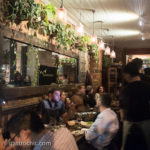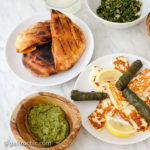Tag Archives: beef
Hill Country
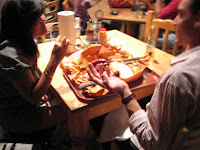 Fette Sau is a hard act to follow.
Fette Sau is a hard act to follow.
This became apparent as soon as we walked into Hill Country. Where was the smell of barbecue? In Williamsburg, the scent of roasting meat bewitches you a block away, here there was barely a whiff of it, even when the counter staff opened the cantilevered storage units that contain piles of brisket, beef ribs, and fatty pork.
 Manhattan might mean “island of many hills,” but this ain’t the boonies anymore. If Texas-inspired Hill Country exuded that barbecue scent, the neighbors would be hoppin’ mad. (It’s tough not to lapse into Texas talk as soon as you get here, what with the honky tonk music on the stereo.) On the other hand, Hill Country is conveniently located just blocks away from several subway lines, and this, as my fellow diner the Cheese Guy pointed out, is its biggest advantage. The cavernous hall, lined on one side with piles of firewood, chock full of wooden tables, and punctuated by BBQ and beer stations, easily fills with Manhattan diners, many of them guys in ties. This doesn’t even include the equally cavernous downstairs space, which has several long tables for large parties and live music several nights a week. But dang if it ain’t hard to hear in Hill Country: the acoustics are terrible.
Manhattan might mean “island of many hills,” but this ain’t the boonies anymore. If Texas-inspired Hill Country exuded that barbecue scent, the neighbors would be hoppin’ mad. (It’s tough not to lapse into Texas talk as soon as you get here, what with the honky tonk music on the stereo.) On the other hand, Hill Country is conveniently located just blocks away from several subway lines, and this, as my fellow diner the Cheese Guy pointed out, is its biggest advantage. The cavernous hall, lined on one side with piles of firewood, chock full of wooden tables, and punctuated by BBQ and beer stations, easily fills with Manhattan diners, many of them guys in ties. This doesn’t even include the equally cavernous downstairs space, which has several long tables for large parties and live music several nights a week. But dang if it ain’t hard to hear in Hill Country: the acoustics are terrible.
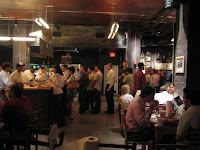 We queued up for ‘cue, which is sold by the pound. In a Katz’s-like system, you get a ticket at the outset and get your own food. This is true to Texas style, so if you prefer table service, chances are you’d be better off in a fancy-pants New York place.
We queued up for ‘cue, which is sold by the pound. In a Katz’s-like system, you get a ticket at the outset and get your own food. This is true to Texas style, so if you prefer table service, chances are you’d be better off in a fancy-pants New York place.
The biggest difference between Hill Country and Fette Sau is the smoker, or lack of a huge, hardworking one like Fette Sau’s Southern Queen. Hill Country’s brisket is juicier than Fette Sau’s, probably because it’s been cooked for a shorter time. But as any barbecue aficionado can tell you, this means it loses something in the flavor department. The 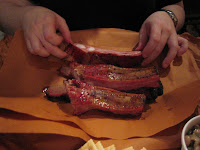 rub on the outside is good, but it doesn’t penetrate far into the beef. The same goes for nicely peppery rub on the pork ribs. And if you ever wonder whether the current Berkshire pork obsession is just spin, contrast and compare the two meats and you’ll taste the difference. Because of the shorter cooking time, Hill Country’s non-Berkshire pork ribs were still pink inside and chewy, not falling off the bone.
rub on the outside is good, but it doesn’t penetrate far into the beef. The same goes for nicely peppery rub on the pork ribs. And if you ever wonder whether the current Berkshire pork obsession is just spin, contrast and compare the two meats and you’ll taste the difference. Because of the shorter cooking time, Hill Country’s non-Berkshire pork ribs were still pink inside and chewy, not falling off the bone.
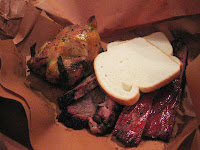 The beer can game hen proved to be a worthwhile experiment. Deep fried with an open beer can inside, it tasted nicely herbal and moist, with crispy skin. It had flavors I didn’t realize hen or canned beer could have. How they managed to wedge a whole can o’ beer in this lil’ critter I’ll never know.
The beer can game hen proved to be a worthwhile experiment. Deep fried with an open beer can inside, it tasted nicely herbal and moist, with crispy skin. It had flavors I didn’t realize hen or canned beer could have. How they managed to wedge a whole can o’ beer in this lil’ critter I’ll never know.
 Unlike Fette Sau, Hill Country is not hostile to vegetarians. There are a heap of sides, many of them meat free. Sharp, slightly oily Longhorn cheddar decked the pasta in the excellent mac-n-cheese, and the corn pudding is perfectly salty-sweet. Black eyed pea salad was ho-hum, and chipotle deviled eggs sounded much more exciting than they were, but they’re a nice apertif to the barbecue if you get hungry waiting in line.
Unlike Fette Sau, Hill Country is not hostile to vegetarians. There are a heap of sides, many of them meat free. Sharp, slightly oily Longhorn cheddar decked the pasta in the excellent mac-n-cheese, and the corn pudding is perfectly salty-sweet. Black eyed pea salad was ho-hum, and chipotle deviled eggs sounded much more exciting than they were, but they’re a nice apertif to the barbecue if you get hungry waiting in line.
 Normally I wouldn’t review a place this early on, but I had an opportunity to go and a camera, so please consider this an early report. Over the course of the evening, however, it became apparent that a lot of thought has already gone into Hill Country. By “thought,” I mean “focus group input.” Like the latest designer fragrance, nothing in the formula offends, but nothing sticks out at you, either. The faux-fluorescent lighting and kitschy props nailed to the walls reminded me of TGI Fridays or Chili’s, though thankfully none of the servers are wearing “flare.” Hill Country has only been open for a matter of weeks, but their in-house barbecue sauce is already for sale at the gift counter by the door, though it’s a pretty average sauce. Setting up a gift counter before you have a devoted following seems like creating your own celebrity fan club before you’re even famous.
Normally I wouldn’t review a place this early on, but I had an opportunity to go and a camera, so please consider this an early report. Over the course of the evening, however, it became apparent that a lot of thought has already gone into Hill Country. By “thought,” I mean “focus group input.” Like the latest designer fragrance, nothing in the formula offends, but nothing sticks out at you, either. The faux-fluorescent lighting and kitschy props nailed to the walls reminded me of TGI Fridays or Chili’s, though thankfully none of the servers are wearing “flare.” Hill Country has only been open for a matter of weeks, but their in-house barbecue sauce is already for sale at the gift counter by the door, though it’s a pretty average sauce. Setting up a gift counter before you have a devoted following seems like creating your own celebrity fan club before you’re even famous.
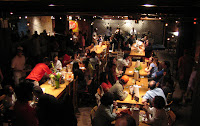 Nevertheless, since this is the kind of free-range place where no one kicks you out, we meandered downstairs to listen to live blues. The luckiest moment of the night came when one of the sous chefs literally tossed Chef Mary and me a bourbon pecan pie at the bar. It was hands down the most delicious pecan pie we’ve ever eaten (sorry, Mom), loaded with fresh nuts and laced with bourbon and molasses.
Nevertheless, since this is the kind of free-range place where no one kicks you out, we meandered downstairs to listen to live blues. The luckiest moment of the night came when one of the sous chefs literally tossed Chef Mary and me a bourbon pecan pie at the bar. It was hands down the most delicious pecan pie we’ve ever eaten (sorry, Mom), loaded with fresh nuts and laced with bourbon and molasses.
The bourbon pecan pie, the sugared bar nuts, the bands, the friendly counter staff, the space for huge parties, and the location are all good reasons to return to Hill Country – and the Kruez sausage is supposed to be a tasty Texas specialty as well, though we didn’t get a chance to try it. But if I have a hankering for pork ribs again, I’ll be danged if I’m not on the first train out to Williamsburg.
Hill Country
30 West 26th Street, between Fifth and Sixth Avenues
New York, New York
212-255-4544
Fette Sau
 Perhaps no other advertising campaign has done a greater disservice to its product than “Pork: The Other White Meat.” Borne out of the fat-phobic late ’80s, the National Pork Board’s campaign reduced the entire animal to the pork chop. If the complex, meaty, by turns fatty and lean pig could talk, she would no doubt tell you: I am so not a chicken.
Perhaps no other advertising campaign has done a greater disservice to its product than “Pork: The Other White Meat.” Borne out of the fat-phobic late ’80s, the National Pork Board’s campaign reduced the entire animal to the pork chop. If the complex, meaty, by turns fatty and lean pig could talk, she would no doubt tell you: I am so not a chicken.
Twenty years later, our obsession with barbecue and pork’s ability to take on and emphasize spicy, smoky flavors may seem new, but it has long been part of the basic vocabulary in Chinese, Korean, Italian, German, and yes, Southern cuisine. Consider this: would David Chang of Momofuku be David Chang without his silent partner, the Berkshire pig?
 It requires a certain mania for the fatty beast to see a barbecue joint in an auto body shop, bring in a crypt-sized Southern Queen smoker, make all the right connections with Berkshire pork suppliers, and open your doors for business. But that’s just what owners Kim and Joe Carroll of Fette Sau have done.
It requires a certain mania for the fatty beast to see a barbecue joint in an auto body shop, bring in a crypt-sized Southern Queen smoker, make all the right connections with Berkshire pork suppliers, and open your doors for business. But that’s just what owners Kim and Joe Carroll of Fette Sau have done.
 By now you probably know what’s on the menu: pork spareribs, pork sausages, pulled pork, plus some beef brisket to give that guy a nod too. But it’s the sau that impresses. Fatty, rich pork belly is like the foie gras of pork products. The ribs are charred on the outside, meaty and tender between the bones. There’s an espresso-and-brown-sugar rub on them, but as with the pulled pork, the true deliciousness comes from the unadulterated flavor of smoke. The Southern Queen smoker – and chef Matt Lang – sure can cook.
By now you probably know what’s on the menu: pork spareribs, pork sausages, pulled pork, plus some beef brisket to give that guy a nod too. But it’s the sau that impresses. Fatty, rich pork belly is like the foie gras of pork products. The ribs are charred on the outside, meaty and tender between the bones. There’s an espresso-and-brown-sugar rub on them, but as with the pulled pork, the true deliciousness comes from the unadulterated flavor of smoke. The Southern Queen smoker – and chef Matt Lang – sure can cook.
I’m no barbecue expert, since I come from Maryland, the no-man’s-land considered the South by Yankees but disdained by Carolinians and ignored by Texans. But barbecue experts have endorsed Fette Sau’s separation of meat from sauce, which you combine yourself at the table. The sweet sauce is the traditional mix of ketchup, vinegar, maybe a bit of Worchestershire sauce, and some other secret ingredients, but it was still my favorite because of my Southern-ish sweet tooth – same goes for the sweet white rolls. Fette Sau’s spicy sauce is a much more complex, mole-like mixture that tastes of coffee, dried chilies, molasses, and unsweetened chocolate. The two would taste great mixed together.
The non-meat sides received a drubbing in previous reviews of Fette Sau, so we skipped these – except for the excellent Gus’ half sour pickles – and headed straight for the baked beans. Embedded with hunks of brisket, they tasted like the ideal incarnation of Fette Sau’s mole-like spicy sauce.
 Though the atmosphere is pretty much the polar opposite of Frederick’s Downtown, Fette Sau does have that see-and-be-seen scene, Williamsburg version, lots of outdoor seating at picnic tables, and few rules. (“No drinks outside after 11pm.”) Walking into the garage, I felt the same kind of relief a teenager experiences upon arriving at a keg party in somebody’s indestructible concrete basement. It’s the kind of place where you can let your hair down, don some Williamsburg style glasses in weird 80’s frames à la Michael Caine, and drink a gallon of beer – literally. A slew of microbrews is dispensed from pulls rigged with butchery tools into gallon-size glass jugs. If that doesn’t spell an afternoon of Brooklyn patio drinking, I don’t know what does. Just get there early because, like Pies ‘N’ Thighs, Fette Sau tends to run out of food, usually by 9:30pm on weekends.
Though the atmosphere is pretty much the polar opposite of Frederick’s Downtown, Fette Sau does have that see-and-be-seen scene, Williamsburg version, lots of outdoor seating at picnic tables, and few rules. (“No drinks outside after 11pm.”) Walking into the garage, I felt the same kind of relief a teenager experiences upon arriving at a keg party in somebody’s indestructible concrete basement. It’s the kind of place where you can let your hair down, don some Williamsburg style glasses in weird 80’s frames à la Michael Caine, and drink a gallon of beer – literally. A slew of microbrews is dispensed from pulls rigged with butchery tools into gallon-size glass jugs. If that doesn’t spell an afternoon of Brooklyn patio drinking, I don’t know what does. Just get there early because, like Pies ‘N’ Thighs, Fette Sau tends to run out of food, usually by 9:30pm on weekends.
 The extensive list of bourbon, whiskey and rye is like the bonanza of breaking into the absentee parents’ liquor cabinet: Whiskey, all you want! We particularly liked the Tuthilltown rye and the Black Maple Hill bourbon. If you’re really daring, knowledgeable bartender Dave Herman will serve you a bit of corn mash liquor that tastes like moonshine: the ceramic jug says it all.
The extensive list of bourbon, whiskey and rye is like the bonanza of breaking into the absentee parents’ liquor cabinet: Whiskey, all you want! We particularly liked the Tuthilltown rye and the Black Maple Hill bourbon. If you’re really daring, knowledgeable bartender Dave Herman will serve you a bit of corn mash liquor that tastes like moonshine: the ceramic jug says it all.
As with a keg party, days later, my clothes still smell like smoke, but this time it’s the alluring scent of barbecue. It even makes me hungry, which is no problem, because like addicted regulars at Fette Sau, I ordered more pulled pork at the end of the night – to go.
Fette Sau
354 Metropolitan Avenue at Havemyer Street
Williamsburg, Brooklyn, New York
718-963-3404
for directions go to hopstop.com
Katsuya
Beware the east-west rivalry in L.A. It’s not East Coast-West Coast, but East Side-West Side, and it resembles the unending uptown-downtown argument here. “I live two blocks from the Central Park” becomes “I can see the ocean from my window.” The usual downtown rejoinder, “No one lives there” becomes “Don’t bother looking for any celebrities in West L.A. None of them live there.”
Of all the maligned West Side neighborhoods, Brentwood fares the worst. It has always mystified me why this place, which looks no different from much of the rest of LA and even features a sort of main street, San Vicente, where people can be spied – gasp! – walking, is so loathed by the rest of the greater Los Angeles area.
Then I went to the new Katsuya in Brentwood, and I understood.
At first, the only thing that struck me as unusual about Katsuya was the design, which is by Philippe Starck. In trademark Starck sexy style, the ceilings are black, the walls polished blond wood, the space low-ceilinged, brooding, yet cavernous, the chairs and tables sleek, the walls decked with lightbox close-ups of lips, made-up eyes, and other enticing motifs.
We sat down at the yakitori bar, ordered, and looked around. That’s when I began to notice something else unusual about the place. A man in his mid-forties with blond surfer hair, a Magnum-P.I.-style mustache, black tee shirt and long platinum chain sat at the opposite corner of the bar, eating dinner with his family, a boy of about eight, also dressed in a black tee and platinum chain, and the boy’s blond mother, whose eyebrows were arched and lips pursed in an expression of continual surprise.
“I think the mother’s had a little too much Botox,” I whispered to California Girl.
“That’s not the mother. The father’s on a date.” We watched the man nuzzle the woman as the son ripped through at least thirty dollars worth of sushi rolls next to them.
What a fascinating glimpse into L.A. culture! I laughed, but California Girl was not amused.
The first course of the omakase arrived. A little fried cone held upright by a bed of sesame seeds ensconced a salmon and crab puree. Smooth and creamy, underlaid with hints of scallion and chili, the puree was the perfect amuse bouche. Next up was a particularly Californian creation, a generous portion of seared tuna paired with tomato salsa. Surprisingly, the flavorful tuna stood up to the salsa, which was very fresh, only mildly acidic, and balanced out by the neutrality of avocado. Beautifully presented with a single marigold riding atop, this was one of Katsuya’s most inventive dishes.
A party of four ladies dined at a table near the sushi bar. One of them wore her sunglasses throughout the meal, although it was dark outside and her table was in a nearly unlit section of the restaurant.
I had to tear my gaze away from the table of ladies when another plate was set in front of me. Fortunately, the kobe beef and foie gras could hold anyone’s attention. The tender, grassy flavor of the rare kobe beef melded with the decadent slice of seared foie gras on top. As you can see by the carbonized look of the dish, it was laced throughout with an intense smoky taste that reminded me of that Liquid Smoke bottle my mother used to keep next to the Gravy Master.
 Keep an eye out for this flavor. Now that barbecue season is nearly upon us, this “Liquid Smoke” factor should be recurring more and more frequently, not just in meats, but in vegetables. You’ll find this flavor not just in Japanese cuisine but in Middle-Eastern dishes.
Keep an eye out for this flavor. Now that barbecue season is nearly upon us, this “Liquid Smoke” factor should be recurring more and more frequently, not just in meats, but in vegetables. You’ll find this flavor not just in Japanese cuisine but in Middle-Eastern dishes.
The actual barbecue was disappointing and plain compared to the allusion to barbecue that preceded it, and there was so much of it. By this point I was beginning to reach my limit. Katsuya doesn’t stint in the portion category, but the omakase was served at a pace that matched a competitive eating event. The reason was obvious: the restaurant was as packed to the gills as I was, and they needed our seats. At times the servers placed the next dish in front of me before I was even finished with the preceding course. Needless to say, this is a highly incorrect way of serving omakase and doesn’t befit a serious Japanese restaurant.
But it was hard to be serious when I was constantly entertained by the crowd. When the table of ladies got up to leave, the sunglassed woman removed her sunglasses as she was walking through the restaurant and beamed at everyone around her. If she was famous, no one recognized her. But we did notice her fur-cuffed jacket, worn on a 65-degree evening.
The presentation of the “lobster confetti” won serious points – lobster tempura wrapped in hundreds of tiny seaweed streamers and served in a pretty wicker basket – but the taste was not up to par with the concept. Overcooked and underseasoned, the lobster made me homesick for the East Coast verison.
Som
e respite arrived in the form of a tomato coulis shooter, a palate cleanser before the sushi. California Girl and I studied a young couple at the other end of the yakitori bar. He was wearing a polo shirt, she in a light, sequined jacket and perfect makeup. They looked to be about 11 and 13, respectively.
“Oh my God,” California Girl exclaimed. “Are they on a date?”
“No, I think they’re brother and sister. Look at them. They look exactly alike.”
Finally, the moment I’d been waiting for: the sushi. If I had to do Katsuya all over again, I’d order all sushi and nothing else. What stood out about Katsuya’s was not so much the artistry of Katsuya Uechi, though he is one of the best sushi chefs in the city. It was his ability to secure supremely excellent cuts of fish, which is no small task in itself. I’ve never been to Masa, but Katsuya’s fish was better than any sushi I’ve tasted on the East Coast. From left to right: you’ll see salmon on toasted rice, tuna, yellowtail, salmon, albacore with caviar, and eel. The yellowtail and salmon were particularly melt-in-your-mouth delicious, and the toasted rice was an interesting twist.
Here’s a chocolate thing that came at the end. I couldn’t eat it by then, but I did like the balls of green tea ice cream served in a sort of gel wrapper.
California Girl returned from the bathroom and nodded towards the 13-year-old.
“She’s got a designer handbag hanging on the back of her chair. What is wrong with people? Where are the parents?”
“They’re right behind the kids, having a dinner party with their friends.”
I thought it was all very amusing. So I was surprised afterwards when someone at a barbecue in Los Feliz (ahem, East L.A.) asked us what we thought of the Brentwood Katsuya and California Girl said: “It was terrible.”
She explained that she liked the food but hated the scene. But the scene was so funny, I said, “like dinner and a show!” It was so L.A.
At this point both California Girl and our Los Feliz host glowered at me. Later I would think that I would have felt the same way if they encountered lots of pushy, rude people in the Meatpacking District and pronounced the place “so New York.”
“It is not L.A.,” they said. “It’s Brentwood!”
Katsuya
11777 San Vicente Boulevard, between Montana and Barrington
Brentwood
310-207-8744
the original Sushi Katsu-ya:
11680 Ventura Boulevard, between Colfax and Tujunga
Studio City
818-985-6976
Starck Katsuyas to come:
Hollywood – Fall 2007
Downtown – Summer 2008
The Hungry Cat
On Day 2 of LA trip, it was decided that we would go to the Hungry Cat. Its specialty? Chesapeake-style seafood. In Los Angeles.
I’m originally from Maryland. Whenever I go back to Baltimore, people there want to take me to someplace that is “really New York.” Here I was all the way across the country, and my friends wanted to take me to someplace with an East Coast seafood. There must be some universal human instinct to offer up your city’s own “authentic” food from the diner’s home state. I was reminded of Pete Wells’ entry in Diner’s Journal. When he offered to take a Texan to an NYC barbecue place, the Texan threatened to take him out in Texas for “Houston pizza.”
Very well. Houston pizza it was. Of course, I was halfway through the meal before I remembered Hungry Cat was supposed to be like Baltimore. Minimalist and sleek, set in an industrial space with an open kitchen and patio seating under heat lamps, the Hungry Cat is unlike anything Baltimore has ever seen.
There aren’t a lot of fancy drinks made with fresh-squeezed juices in crab shacks along the Chesapeake. Hungry Cat’s were damn good. The Hemingway Daiquiri could have been flown in from Key West. The mixologists here even feature a cocktail special of the night, which that night was a blood-orange-infused vodka drink made with vodka they had infused in house.
As they say in DelMarVa, we gots lots of ducks down on the wuter, but we don’t got no duck like Hungry Cat’s. The surf & turf special that night was crackly-skinned duck overlaid with creamy bread pudding mixed with smoked trout, served alongside a frisee salad. As our knowledgeable waiter put it, it was on the “extreme” end of the menu’s offerings, but also amazingly good. The salty crispness of the duck went surprisingly well with smoked trout. It was an impressively creative dish.
According to many an LA Chowhound user, Hungry Cat’s oysters are some of the best in town, so we ordered up a dozen of these. There were no Kumamotos, and only one variety, the Hama Hama, was West Coast, so I would have to order East Coast oysters here. This was initially disappointing until we tasted the Chincoteague oysters, which were large, plump and briny – definitely as good as any I’ve had in Maryland.
When our theatrical waiter delivered an enticing monologue about the lobster rolls, I turned to the Kobra, who lived in Boston.
“Are you going to get that?” I really wanted him to order it so I could see what he thought. The instinct to get someone to eat his hometown food somewhere else was kicking in.
“No,” the Kobra said. “I never order lobster rolls outside of Boston.”
And I passed on the crab cakes, since I never order crab cakes outside of Maryland. Wooed by the waiter’s reenactment of removing the cheek of an especially large deep-sea halibut, I ordered this dish. The fabled halibut cheek arrived as lightly breaded and fried hunks of fish tumbled onto more bread pudding. N.B. that I have never once encountered bread pudding on a Maryland menu, yet it was a recurring theme at Hungry Cat. I imagine it was a staple on the Eastern Shore around 1820.
Nevertheless, the bread pudding was quite good, as was the halibut. Presumably this was the fish version of Batali’s obsession with beef cheeks. As with beef, the cheeks were an especially tender and light cut of the halibut, and Hungry Cat’s were expertly prepared. The one disappointment was the morels on top. Though they added a lot of flavor to the sauce, the reconstituted mushrooms were still a little tough and chewy.
Oddly for a seafood place, the Hungry Cat is especially famous for its PUG burger, so named because one of the owners has a pug. He sure tastes delicious. A debate ensued about what made the PUG burger so good, other than that naughty dog that got sent to the hamburger factory.
“It’s the bacon,” Fellow WASP’s husband said.
“No, it’s the blue cheese,” Fellow WASP said.
The smoky flavor of the slow-cooked, chewy, fatty bacon – could it be applewood smoked, like the bacon from Huntington Meats? – was the first thing that struck me too, until I started to deconstruct the taste and wondered if the tang of blue cheese was the key. The sharpness of the cheese kept the whole thing from derailing into absolute fattiness. Each element was absolutely essential. Maybe burgers should never be made without blue cheese and bacon from now on. Unfortunately, we can’t credit an East Coast seafood place with inventing this dish either.
California Girl’s salmon dish looks intriguing, but I didn’t get to it until some of the key ingredients were gone, like this poached egg on top. The salmon itself was a little overcooked, but the buttery noodles that came with were good.
To anyone who grew up eating seafood on the East Coast, there might be something charmingly amusing about the Hungry Cat. Rarely have crab cakes been paired with fava bean puree and harissa aioli. Peel ‘n’ eat shrimp don’t usually appear on the same menu as caviar. Things that are plain and simple out East are a little more complicated here. Lest you think that the Hungry Cat is trying to make a silk purse out of a sow’s ear, however, you need only note that their respect for
the ingredients, however plain or fancy, is absolutely sincere. And by elevating them to a new level, the staff could even teach East Coasters a trick or two.
 The Hungry Cat
The Hungry Cat
1535 North Vine, at Sunset
323-462-2155
Also in Santa Barbara
Del Posto Enoteca
The room is hushed. Piano music tinkles in the background. Nearly everybody in the joint is talking business over a nice bottle of red and a good Italian meal. But the place is so well soundproofed, carpet and cushions everywhere, foam padding the underside of the tablecloths, you couldn’t even hear the guy at the table next to you if he was planning a hit. Now if only Artie would quit coming by with that pathetic bandaged hand of his and going on and on about the specials.
That last part didn’t happen. But all night at Del Posto Enoteca, we felt as if it might. Having read about the enoteca on one of Ed Levine’s top 2006 lists for its $41 prix fixe, I expected Del Posto’s to be like the front room at Gramercy Tavern – an energetic, casual setting with diners spilling over from a bar that stretches along one side of the room. Del Posto has the long bar, but the dining space surrounding it has the muted, formal feel of a suburban Italian restaurant that prizes itself on being “the best” in the area. My chef friend mentioned the Sopranos, and from then on I couldn’t help thinking of the place as a mega-Vesuvio’s, Artie’s dream come true.
Unlike Vesuvio’s, Del Posto is known for its great food, so we came in with high expectations. These were matched by the first course and gradually deflated by the ones that followed. Was it just an off night? Give me an expense account and I’ll give you an answer. But there was no doubt this was a Mario Batali operation when lardo, which first appeared on the table as a spread for bread, reappeared decadently drizzled all over the beef carpaccio, which had a fabulous sashimi-like texture. Lift up the carpaccio, and underneath you’ll find a pool of wonderfully fragrant extra-virgin olive oil. Tender, delicate calamari came fried in the lightest tempura-like batter and had a lingering spiciness from the cherry peppers and lemony tang from the capers. The octopus with fried celery and beans was tender and sweet.
Moving on to the primi, we got into wildcard territory. The veal and cauliflower ravioli were amazing, but the bucatini was a strangely bright shade of red and had too much heat and salt. Was Del Posto trying to do a version of Sara Jenkins’ red wine spaghetti at 50 Carmine (R.I.P., 50 Carmine) with an inadvisable cherry pepper reduction? The gnocchi with ragu bolognese, with its subtle hints of fennel and nutmeg, was much more successful.
Who would order the best entree? It turned out to be the fiancée of the Master Orderer, who, as was mentioned in this Café Gray review, always manages to order the best dishes on the menu by employing some sort of gastronomic ESP. His skill must have rubbed off on her, since she was enjoying the bass with lentils as my chef friend picked at her so-so cod. The lentils introduced a nice new flavor to the mix, which was beginning to taste of the same few base notes after three courses. Also – and I can’t believe I am saying this, since I am a confirmed saltaholic – many of the dishes at Del Posto Enoteca were oversalted. The lentils were the one ingredient that could cut through the salt. My steak braciolona, which, though it was cooked rare, tasted only of the red wine marinade through and through (and some more salt). We pronounced it “weird.”
The service was also strange. Extremely attentive one moment but M.I.A. the next, our waitress seemed to realize at one point that we were waiting 30 minutes between courses after the enoteca got slammed at 8 o’clock. She refilled our wines-by-the-glass for free, which was particularly fortunate because the wine there can run $24 a glass. Next time I’ll order a bottle.
Fiancée of Master Orderer again triumphed at dessert with the rich chocolate cake that tasted of amaretto. My chef friend managed to break through the shell of her tarte without the assistance of a jackhammer, though it was a challenge. And by then I had a cold coming on, so all that I could taste of the gelato was that it was cold and vaguely chocolatey.
As we were leaving, we saw a lone woman with short, fluffy hair, reading glasses and a pink cashmere scarf sitting at the bar, staring out into space. No one in Del Posto’s businessman clientele seemed to recognize her, but we stopped by to say hello to Lidia Bastianich. I hope she scolds her sous-chefs as she scolds her television audience about oversalting .
I bid my girlfriends goodbye, trundled into my new Porsche station wagon (paid for in cash), and sped off towards the Holland Tunnel.
 Del Posto Enoteca
Del Posto Enoteca
85 Tenth Avenue, between 15th and 16th Streets
212-497-8090















